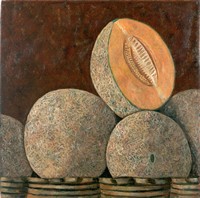Cynthia Palacios Goya
The Naturalistic Themes of Pedro Diego Alvarado Painting, An Integral Part of Life At a time when life is peaceful and work is much calmer, since the passing of the years have curbed the youthful impulse of wanting to be recognized by any means, Forty-four paintings in oil and tempera on canvas and four pieces of glazed ceramic, created in the last two years in Mexico and Europe, are on display: “The themes in my work normally tend to revolve around nature; though, technically there are differences. Before traveling to the Old Continent I worked with pigments, egg tempera and oil. I’d place a layer of each and then varnished with an opaque film (a thick white); however, now I work with oil and tempera only”.
Alvarado comments that for the most part he bases his work on the natural state of objects, though sometimes he does take photographs because they can help with a detail at any given moment. “Before, all my work was based directly on the natural settings and to do it I had to move all my instruments to the place I wanted to paint, since I was incapable of taking a good sketch and working in my studio. However, one of the things I learned on my last trip to London—where I worked with the master painter Armando Morales—is to paint the smaller pieces in two sessions. That’s why there are large paintings that took me over a month to do. With this new method of working I have stopped the mania of leaving my studio all the time, or going to see the model constantly". "Now,” he says, ”I do a small paintings and rework them in a larger format; and that’s when the imagination game begins for me that is very important; the painter’s perception, of color and of form, there are even emotional factors involved". Grandson of the muralist, Diego Rivera, he says that when working from nature he really enjoys working with the light, “since (light) acts differently according to the place or even the country where you are; Pedro Diego Alvarado, who in 1993 entered the National System of Artistic Creators, explains that his painting is naturalistic, perhaps because of the influence of photography: “I began as a photographer, but the fact that Henri Cartier-Bresson set aside his camera at the age of 70 to draw left a big impression on me. So, I too left photography and began to draw and eventually I began to color my drawings, particularly during the time I worked in the studio of Ricardo Martinez, which is where I learned to paint, where I became interested in painting. I believe that everything is in nature, even abstractions, it all comes from there; it has a reading of rhythms and color, which is what interests me". Alvarado emphasized that his work does not pretend to be ecological: “Today, men’s perceptions are atrophied by the large quantity of visual information that surrounds us, publicity, television. Everything enters through the eyes; we move very quickly, which is why I am interested in recovering those interesting movements given to us by nature, at a time when I feel new generations create work that is not made to last forever, but rather to sell quickly”. Unhurriedly, Pedro Diego Alvarado finishes by saying that he has a lot of fun painting: “For a painting to turn out right it must be created with pleasure and enjoyment. Of course, not all the creative process is fun, since every painting is a new problem that must be either resolved or abandoned. I work in solitude, as if in confrontation with myself, since painting has become an integral part of my life, a constant adventure, a search with its good sides and its bad”. El Nacional |
|

 Mexican painter Pedro Diego Alvarado (Mexico City, 1956) presents his most recent work at the Galería de Arte Mexicano.
Mexican painter Pedro Diego Alvarado (Mexico City, 1956) presents his most recent work at the Galería de Arte Mexicano. In a brief chat, the artist commented that for the last three decades his motivating principal has been to recuperate the painter’s craft, which, he states, is “something that has almost disappeared as a consequence of the emergence of modern art”. Still lifes make up most of his recent production (he prefers the term “still life” in English rather than the term “dead nature” in Spanish) “because, if fruits or flowers are dead, there is no sense in painting them any longer. ´Dead nature´ is something dead: on the other hand, in English or German, the term is translated as ´still life´, because that is precisely their feature, that they don’t move, so there is not a struggle against time”.
In a brief chat, the artist commented that for the last three decades his motivating principal has been to recuperate the painter’s craft, which, he states, is “something that has almost disappeared as a consequence of the emergence of modern art”. Still lifes make up most of his recent production (he prefers the term “still life” in English rather than the term “dead nature” in Spanish) “because, if fruits or flowers are dead, there is no sense in painting them any longer. ´Dead nature´ is something dead: on the other hand, in English or German, the term is translated as ´still life´, because that is precisely their feature, that they don’t move, so there is not a struggle against time”. it has to do with the culture, with the fruit that it produces. For example, in Mexico we have a very strong light—not so much in Mexico City because of the smog—but in the country it is very intense”.
it has to do with the culture, with the fruit that it produces. For example, in Mexico we have a very strong light—not so much in Mexico City because of the smog—but in the country it is very intense”.